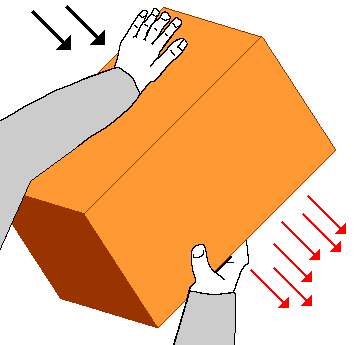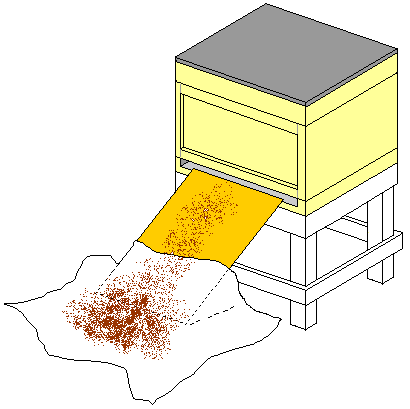Swarms and Swarming - Index
Manipulations - Index
Hiving a Swarm
Swarm Collecting
Swarm Boxes
|
|
|
|---|
|
Swarms and Swarming - Index Manipulations - Index Hiving a Swarm Swarm Collecting Swarm Boxes |
Ways of Hiving a Swarm |
|---|
This page was written by Dave Cushman, but has been renamed and replaced. I have retained it because of the drawings and the relevant text. Press the button "Hiving a Swarm" on the top left for the page that more fully describes hiving a swarm. R.P.
Once we have collected a swarm we have to put it in a hive in such a manner that it won't abscond, otherwise it would waste our effort in capturing it and someone else may have a chimney full of bees they don't want. If the swarm is local it has already decided where it wants to make it's new nest and the chances are it won't be your hive. Don't forget that bees seem to set a few criteria when selecting their own site. They prefer to go where other bees have been before, so may not like a brand new or disinfected hive. They choose somewhere they can easily defend, so close the entrance down and don't use an OMF as they presumably think it's fully open. (I'm convinced bees like their nest to be on a point where four or more energy lines cross. This is dismissed by many people, but I suspect that being placed in a position with no energy lines is a major reason for swarms absconding R.P.).
It is normally advised to hive a swarm in the evening so it has time to settle in overnight, but in my experience they are just as likely to abscond the following day. In my experience a swarm can be hived at any time. They don't naturally wait until the evening, so why should we?
The makeup of the swarm receiving hive may have some bearing on the effectiveness of the hiving operation. The mechanical part of the operation is usually conducted by using one of two methods. The traditional way of doing it with a board sloping up to the hive entrance and the straight forward "chucking them in" methods, both of these will work. Whichever of the two methods we are going to use involves "throwing" the bees out of the swarm box... This is illustrated at right and is not a violent action, but one that is a firm enough thump, using the heel of the palm, to dislodge the bees from their clustering in the box and disorient them sufficiently, so that they do not fly up in a cloud. |

|
|---|
|
Throwing them straight into the top of a hive. This is the method that I have used most often. Although I have had a few failures it is generally a reliable method. Prepare your hive as shown in the diagram at right. Throw the bees into the gap in the middle of the box and put the loose combs gently on top of the pile of bees. Allow the frames to sink as the bees disperse, then when they have dropped to their normal position brush any loose bees inwards, finally placing the roof in position. |

|
|---|
|
This is the traditional way that it is done. The hive is prepared with frames in place. If there are any gaps the bees are likely to build wild comb. A ramp is made using a board from the ground sloping up to the hive entrance. The bottom portion of the board can have a cloth spread over it, encompassing an area of ground in front of the hive to stop the bees from going under the board. Finally the bees are thrown onto the board, which they will crawl up and start fanning at the entrance, whereupon all the bees then scuttle up the ramp and into the hive. If you throw the swarm on the bottom of the board it gives a longer distance for the queen to run up, making it easier to catch her, so you can clip and mark her. Queens are usually quite easy to spot. Fertile queens move quite sedately, but virgin queens flit about more and may run over the other bees. |

|
|---|
As with all things in beekeeping there are many ways of achieving the same thing. If it suits you and it works, then use it. Swarming time often shows the inventiveness of beekeepers!
Original material by Dave Cushman, edited by Roger Patterson.
Page created Sept 2000
Page updated 27/12/2022